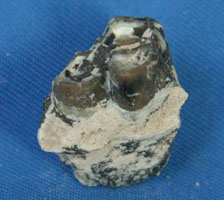Poebrotherium means grass eating beast. Early camels did not have a hump, like today's camels, but more closely resembled present day alpacas and llamas and are likely related to them. They were, perhaps, two feet tall and weighed 50 pounds (roughly the size of modern sheep). They are fairly rare. In spite of the fact that it is named "grass eating beast," it is likely that its diet was either a browser or a mixed feeder and that grass probably played a minimal role.
The Poebrotherium skull is approximately seven inches long. The skull is long and thin. Because of this complete skulls are very rare. Teeth near the front of the jaw are smaller in size and peg like and more adapted to plucking while those farther back are more adapted for grinding. The peg like teeth would have been located in the premaxilla. The three premolars and three molars would have been in the maxilla.
Because of replacement minerals, many of the fossil mammal teeth from the White River Formation of South Dakota will fluoresce. Be sure to check them out in our fluorescent section under the South Dakota page and then by the appropriate page for the species you are interested in. The item number will be the same as the item number in this section, but will be followed by an "F."
Specimen is premaxillary molar teeth.
Kingdom: Animalia, Phylum: Chordata, Class: Mammalia, Order: Artiodactyla, Family: Camilidae, Genus: Poebrotherium, Species: wilsoni.
Camel - Poebrotherium wilsoni 
Quantity in Basket: None
Code: TSDC-109
Price: $10.00
Shipping Weight: 0.19 pounds
Time: Early Eocene through Early Oligocene, approximately 40 - 30 million years ago.
Location: White River Formation, South Dakota Badlands, USA
Dimensions: 1/2" x 1/2" x 3/8"